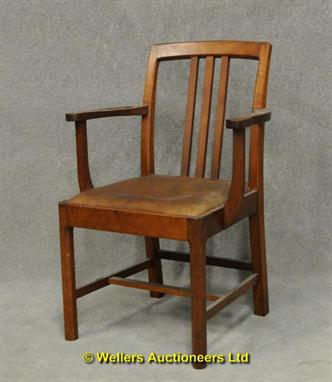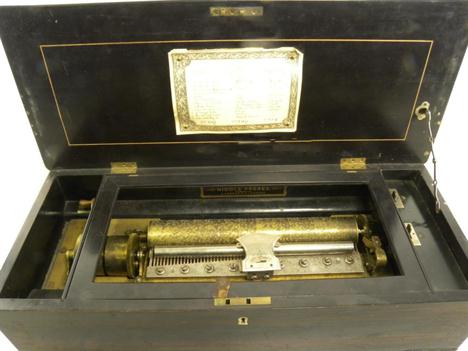We found 20273 price guide item(s) matching your search
There are 20273 lots that match your search criteria. Subscribe now to get instant access to the full price guide service.
Click here to subscribe- List
- Grid
-
20273 item(s)/page
A pair of silver dishes, Sheffield 1996, of circular shaped outline with a moulded rim, 12.5cm diameter; a silver heart shaped box, with a hinged cover; a comb with a silver spine; a silver backed brush; 196g (6.3 oz) gross weighable; a pair of small swan table ornaments, stamped `80`; an Egyptian small table lighter in the form of a Roman lamp; and an Egyptian matchbox holder; both with stamped marks
A Third Reich Double Decal Feuerschutzpolizei (Fire Protection Police) Helmet, the light alloy shell retaining its original black painted finish, with `salt shaker` ventilation holes and Polizei eagle and NSDAP party shield decals, the inner rim stamped `B x F - Vorschriftsmassig - Lt. Gesetz - 3.5.34` with light alloy comb, and original liner and chin-strap.
A late 19th Century Rosewood Boxwood Line Inlaid and Ebonised Music Box, No 16199, and playing six airs, the rectangular case with hinged cover and line inlaid borders with central floral sprig, to a painted rosewood simulated body to an ebonised interior with tune sheet, decorated with dancing putti and musicians, to a glazed interior with side ratchet handle, to an 8 3/16” pin barrel, and single piece comb (teeth lacking), width 17”
Large selection of miscellaneous silver, including nine piece silver mounted dressing table set, comprising four hair brushes, mirror, comb, button hook and shoe horn and a dish (Birmingham 1915 / 1917 / 1919 / 1920), ornate Italian silver photograph frame, large silver mounted cut glass globe perfume bottle (Birmingham 1902), George V silver and tortoiseshell powder box (London 1918) and sundry other items - various dates and makers (qty) Further images and condition reports are available at www.reemandansie.com
* A 20th c. part suit of armour, comprising steel and brass close-helmet, one piece skull with high comb, brass plume holder, pointed visor with single vision slit, back plate with brass heraldic eagle crest, a pair of gauntlets, and a shield with embossed brass shield-shape plaque depicting a knight on horseback impressed `Toledo` (1)
A late 19th/early 20th century German walnut cased "Symphonion" mantle clock, the case of architectural form with cupola and finials to the roof, flanking half column and stepped shallow plinth and the 8 day movement having gilt metal and cream enamelled dial with Arabic numerals together with four Symphonion discs (as viewed, the movement in need of attention and 2 teeth broken from the comb, top finial damaged, 51cms high)
A SWISS MUSICAL BOX BY NICOLE FRERES PIN CYLINDER AND ONE PIECE COMB WITH ZITHER ATTACHMENT, CONTROL LEVERS, WINDING CRANK AND PRINTED TRADE LABEL TO THE UNDERSIDE OF THE LID INSCRIBED TWELVE AIRS SYMPHONY AND NUMBERED 3137/51097/5129 IN EBONISED AND INLAID ROSEWOOD VENEERED CASE, LATE 19TH C
A grooming monkey tinplate toy, probably Japanese, fabric covered and holding a comb in one hand and a mirror in the other, with a clockwork mechanism, the foot with label marked `Foreign`, 12.5cm high; assorted Japanese celluloid dolls, including a `kewpie` modelled as a teacher, 15.5cm high; a Japanese celluloid baby in a pram, with a clockwork mechanism, 10.5cm long; a painted lead model of Sairey Gamp, 7.5cm high; and assorted other items, some boxed.
A silver plated tray, of canted rectangular form, incised with floral decoration, with angled gallery and beaded edge, on hemisphere feet, width 49 cm, a silver salt, of circular form and on three pad feet, two white metal salts, with glass inserts, a white metal brush and comb, a white metal mirror holder and stand, a silver and green enamel top perfume bottle, together with four silver cased pocket watches, a Murano style glass vase, of lobed flaring form with handle and a green glass vase, (a lot).
A leather Gladstone travelling bag, 20th century, width 35 cm, with push button opener, containing a range of ivory implements including, card cases,a pedicure set, hair brushes, glove stretchers, pots, a comb, a shoe horn, silver topped glass jars, two notepads, a white metal pot and a mother of pearl and metal bon bon scoop, (a lot).
-
20273 item(s)/page






















































